Physical Address
304 North Cardinal St.
Dorchester Center, MA 02124
This chapter includes cutaneous substances that may accumulate in abnormal amounts, such as mucin, as well as material deposits usually not present in the skin, either produced endogenously (e.g., porphyrins) or introduced as a foreign substance (e.g., tattoo pigment). Deposits in the skin may be divided into broad groups: (1) calcium, osseous, and cartilaginous deposits; (2) hyaline deposits characterized by an eosinophilic, homogeneous, glassy appearance in hematoxylin and eosin (H&E)–stained preparations, which include amyloid, lipoid protein, colloid milium, porphyrins, and gout; (3) various pigmentary deposits, such as ochronosis, hemosiderin, tattoo pigment, and various metals; (4) substances used for cosmetic purposes; and (5) miscellaneous deposits, such as oxalate and polyurethane. The chapter also includes solar elastosis and pseudoxanthomaelasticum (PXE).
Dermal mucin is composed of acid glycosaminoglycans, particularly hyaluronic acid, and to a lesser extent chondroitin sulfate and heparin. They are normally present in the ground substance of the dermis and may abnormally accumulate either diffusely or focally in the dermis.
Cutaneous mucinoses can be divided into two groups: (1) primary cutaneous mucinosis, in which mucin deposition is the main histologic feature resulting in clinically distinctive lesions, and (2) secondary mucinosis, in which mucin deposition is not the principal but one of several other findings because it can be seen in conditions such as lupus erythematosus, scleroderma, dermatomyositis, Degos' disease, and granuloma annulare.
Mucinoses with altered thyroid function
Thyroid dermopathy (pretibial myxedema)
Generalized Myxedema
Lichen myxedematosus (papular mucinosis)
Generalized and sclerodermoid (scleromyxedema)
Localized
Scleredema
Reticular erythematous mucinosis
Mucinosis of connective tissue diseases
Cutaneous focal mucinosis
(Digital) Myxoid cyst
Mucocele of the lip
Primary follicular mucinosis (Pinkus)
Urticaria-like follicular mucinosis
The major primary mucinoses are generalized myxedema, pretibial myxedema, lichen myxedematosus, reticular erythematous mucinosis (REM), scleredema, papular and nodular mucinosis of connective tissue diseases, cutaneous myxoid cyst, cutaneous focal mucinosis, and follicular mucinosis.
In Generalized Myxedema caused by hypothyroidism, the skin appears pale yellow because of the combined effects of edema, anemia, and carotenemia. The skin is cool, dry, coarse, waxy, and puffy, especially around the eyes, nose, and cheeks, and firm to touch. The face is often expressionless with a broad nose, swollen lips, and puffy eyelids.
Localized (pretibial) myxedema is most often associated with hyperthyroidism. It occurs in 3% to 5% of cases. It is one of three processes classically seen in Graves' disease, the other two being exophthalmos and thyroid acropachy (clubbing of the digits associated with subperiosteal new bone formation). Pretibial myxedema is usually a late manifestation of Graves' disease. Only rarely has it been reported preceding the diagnosis and occurring in the setting of Hashimoto's thyroiditis without thyrotoxicosis or hypothyroidism after treatment of Graves' disease and even in euthyroid patients.
In pretibial myxedema, typically, pink or yellow raised, nodular, waxy plaques and sometimes “tumors” develop, most frequently first on the anterolateral aspects of the lower leg but sometimes extending to the dorsum of the feet. In some patients, the skin is indurated with prominent follicles, giving rise to peau d'orange appearance. Infrequently, localized myxedema occurs on other sites such as the arms, shoulders, abdomen, neck, face, and even the ears. Pretibial myxedema is sometimes self-limiting, involution occurring after a number of years.
There are two forms of lichen myxedematosus (papular mucinosis) , a generalized and sclerodermoid form also called scleromyxedema and a localized form. Scleromyxedema occurs equally in men and women and is seen most often in the fourth and fifth decades of life. Clinically, a widespread symmetric eruption of 2- to 3-mm, firm, waxy, closely spaced papules occurs on the hands, forearm, face, upper trunk, and thighs. Papules are commonly arranged in a linear fashion on an underlying sclerodermoid background, resulting in tethering and limitation of movement. The glabella is typically involved with deep longitudinal furrowing. Scleromyxedema is almost always associated with a monoclonal gammopathy (usually IgG-lambda) and with systemic manifestations (e.g., myositis, carpal tunnel syndrome, or neurologic dysfunctions).
In the localized form, patients exhibit small, firm, waxy papules (or nodules and plaques produced by the confluence of papules) without sclerotic features, paraproteinemia, or systemic findings. The localized form includes several variants, including discrete papular form of lichen myxedematosus lesions occurring at any site, acral persistent papular mucinosis, cutaneous mucinosis of infancy, and nodular mucinosis. Self-healing juvenile cutaneous mucinosis can be considered as a peculiar variant of cutaneous mucinosis of infancy.
Reticular erythematous mucinosis is a photo-aggravated, erythematous reticulate or plaque-like eruption in the middle of the chest or back. This condition usually affects young to middle-aged women. Rarely, the face and arms are involved. The eruption is asymptomatic. Sunlight and hormonal influences exacerbate and induce mild pruritus. It's relationship with lupus erythematosus tumidus is controversial.
Scleredema (Buschke disease) is a rare primary mucinosis that presents with nonpitting indurated edema in the absence of any significant clinical abnormality of the overlying skin. The condition may occur at any age, but nearly 50% of cases develop in children and adolescents. It may be acute or insidious in onset and may be associated with late-onset diabetes mellitus. The most common presentation is acute, which predominantly affects children and is characterized by a rapid onset arising a few weeks after an infection, most often of the upper respiratory tract. Streptococcal infections are particularly implicated. Scleredema has also been described in HIV infection and has been reported in association with paraproteinemia. Patients present with nonpitting edema and dermal hardening mostly of the posterior and lateral aspects of the neck but also of the face, anterior neck, upper trunk, and upper limbs. Lesional skin is shiny and feels hard. Wrinkling is impossible. The face may be expressionless.
Mucin deposition as a specific clinical manifestation of lupus erythematosus occurs in up to 1.5% of dermatologic patients. Papular and nodular cutaneous mucinosis associated with lupus erythematosus presents as asymptomatic, flesh-colored, occasionally umbilicated papules and nodules on the neck, trunk, and upper limbs. Mucin deposition occurs most often in patients with the systemic variant, usually with diffuse antinuclear factor and anti-DNA antibodies, and is particularly associated with joint and kidney involvement, but it has been reported in subacute and discoid lupus erythematosus. Similar eruption characterized by papules, nodules, and plaques have been described in dermatomyositis and scleroderma.
Digital myxoid cyst presents as a soft or fluctuant cystic nodule on the fingers, in particular the dorsal aspect of the distal interphalangeal and the metacarpophalangeal joints. Occasionally, lesions are multiple. Cutaneous myxoid cysts may present at any age and are more common in females. They contain yellow, clear viscous fluid and are often painful or tender. Myxoid cyst involving the proximal nail fold may be associated with longitudinal grooving of the nail.
Cutaneous focal mucinosis presents as an asymptomatic, usually solitary, benign dermal papule or nodule most commonly on the face, neck, trunk, or extremities of adults. The lesion is usually dome shaped, white, or flesh colored and sometimes has an erythematous halo.
Pinkus' follicular mucinosis is a benign form of intrafollicular mucin deposition not associated with cutaneous T-cell lymphoma. Children and young adults present with one or several plaques of grouped follicular papules located on the face and scalp and associated with alopecia. Nodules, annular plaques, folliculitis, follicular spines, and acneiform eruptions have also been described. A second more generalized form occurs in older patients and is commonly associated with T-cell lymphoma.
Mucin presents as basophilic amorphous or granular material in H&E-stained sections ( Fig. 6-1 ). Excess mucin disrupts the collagen fibers, giving them a frayed appearance. Mucin deposition may be associated with an increase in the density of fibroblasts.

There are subtle changes with only small interstitial, sometimes perivascular and perifollicular, deposits of mucin through the dermis. The epidermis may show mild hyperorthokeratosis with occasional follicular plugging. Fibroblastic proliferation is not a feature of primary generalized myxedema.
Mucin deposition involves diffusely the mid- and lower dermis ( Fig. 6-2 ). The epidermis may be hyperkeratotic, with follicular plugging. Stellate fibroblasts are evident and referred to as mucoblasts, but they are not increased in number except perhaps for the more elephantiasic examples. There is a mild superficial perivascular chronic inflammatory cell infiltrate. Mast cells are often present.
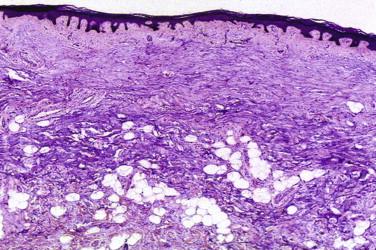
There is a characteristic triad of diffuse mucin deposition in the upper or mid-dermis, prominent fibroblast proliferation, and increased collagen (see Fig. 6-3 ). A slight perivascular lymphoplasmacytic infiltrate is often seen in the superficial dermis. Mast cells and eosinophils are sometimes increased in number. With consequent fibrosis and dermal thickening, mucin deposits may become less evident. A granulomatous variant has been described. The histopathologic picture of the discrete type of localized lichen myxedematosus is not as characteristic as in scleromyxedema but is still recognizable. Mucin deposits are diffuse or focal, in the upper and mid-dermis with variable fibroblast proliferation and slight or absent fibrosis.
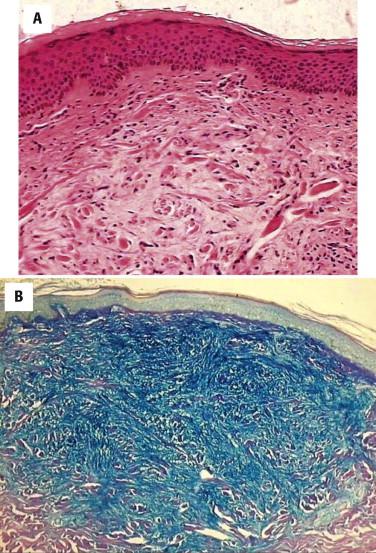
The deposits of dermal mucin in the upper or mid-dermis are small, and a mild or moderately pronounced lymphocytic infiltrate is present, predominantly around blood vessels and hair follicles ( Fig. 6-4 ). The relationship of REM with lupus erythematosus tumidus remains controversial.
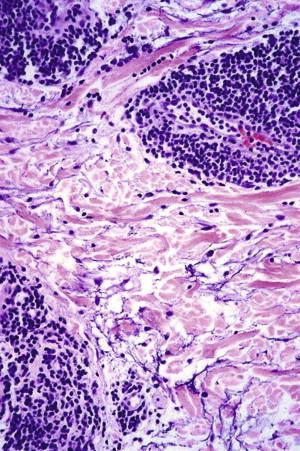
There is a diffuse, variable interstitial deposition of mucin in the reticular dermis ( Fig. 6-5 ). The reticular dermis is greatly thickened, often at the expense of the subcutaneous fat, because of swelling and separation of collagen bundles. Eccrine glands therefore become abnormally situated within the upper third or mid-dermis. Sometimes multiple biopsies are necessary for demonstrating mucin. Fibroblasts are in normal number. Inflammatory infiltrate is often absent.
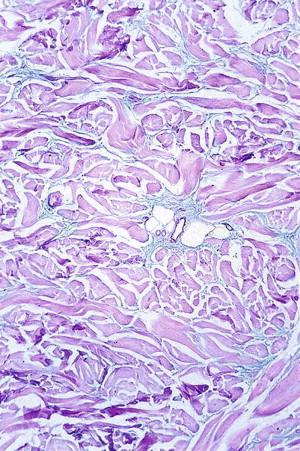
Mucin is present in the papillary and upper reticular dermis with a diffuse pattern. A slight to moderately dense perivascular lymphocytic infiltrate is only occasionally present. The epidermis is normal, and no signs of interface dermatitis are present.
There is no “true” cyst with cyst lining. The lesion consists of a pool of mucin associated with spindle or stellate fibroblasts ( Fig. 6-6 ). The overlying epidermis may be atrophic or hyperplastic and hyperkeratotic with a collarette surrounding the dermal pool of mucin.
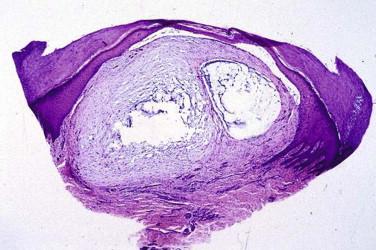
A mucocele or mucous cyst results from rupture of the duct of a minor salivary gland. It most often affects the lip but may also develop in the buccal mucosa. Clinically, mucoceles are translucent or whitish cystic nodules. Histologically, there is a mucinous stroma but no epithelial-lined cyst. The associated inflammatory reaction varies greatly from a minimal infiltrate to granulation, tissue, fibrosis and mixed inflammatory cells, including neutrophils and macrophages.
There is a focal accumulation of mucin in the dermis ( Fig. 6-7 ). A slightly increased number of spindle cells and stellate fibroblasts with elongated cytoplasmic processes are often seen, sometimes containing conspicuous intracytoplasmic vacuoles. Collagen fibers are usually diminished in number. A mild perivascular chronic inflammatory cell infiltrate is often present in the adjacent dermis. Some cases are associated with epidermal hyperplasia.
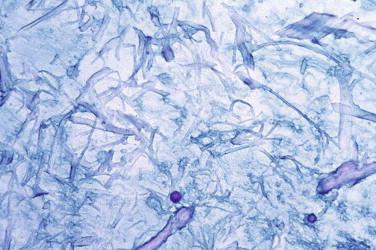
Mucin accumulates within the follicular epithelium and sebaceous gland with some dissolution of cellular attachments ( Fig. 6-7 ). Sometimes the follicles are converted into cystic cavities containing mucin, inflammatory cells, and keratinous debris. A perifollicular infiltrate of lymphocytes, histiocytes, and eosinophils is seen.
Self-healing juvenile cutaneous mucinosis is a rare disease affecting young individuals. It is characterized by the acute eruption of multiple papules and plaques or nodules, which may be associated with systemic symptoms. Two types of self-healing lesions occur: papules showing mucin deposition with mild inflammation and a small increase in fibroblasts and nodules showing deep mucinous areas associated with bands of fibrosis, multiple capillaries, fibroblastic proliferation and gangliocyte-like giant cells in the fat. Knowledge of this entity is important to avoid over treatment of a transient usually self-healing condition.
If one suspects mucin deposition because of light-blue staining between widely separated collagen bundles or empty spaces, special stains should be used, such as Alcian blue at a pH of 2.5 ( Fig. 6-8 ) (negative at 0.5) or colloidal iron at least.
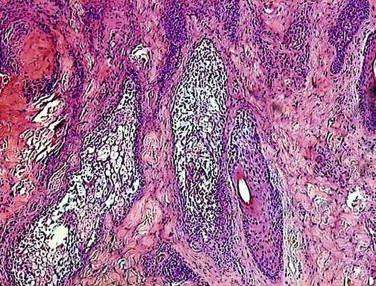
Mucin also stains red with mucicarmine and stains metachromatically with toluidine blue at a pH of 7.0 or 4.0 but is negative at a pH of 2.0. Furthermore, mucin is hyaluronidase sensitive and periodic acid-Schiff (PAS) negative. Sulfated acid mucins, which are characteristic for mucopolysaccharidoses, stain with Alcian blue at a pH of 0.5 and aldehyde fuchsin. They are not discussed in this chapter.
Immunofluorescence study results are usually negative in pretibial myxedema, reticular erythematous mucinosis, and scleredema. In lichen myxedematosus, there is immunoglobulin (IgG more than IgM) in the reticular dermis or just below the epidermis in about 35% of cases.
In papular and nodular cutaneous mucinosis of SLE, direct immunofluorescence (DIF) may show linear or granular immunoglobulin (IgG, IgM) deposits and complement at the dermal-epidermal junction.
Pretibial myxedema must be differentiated from pretibial mucinosis associated with venous stasis seen in patients without thyroid disease. In pretibial mucinosis, the excess mucin is localized to the thickened papillary dermis and is accompanied by angioplasia and siderophages.
The lack of acral calcification, absence of Raynaud's phenomenon, the papular component, and the absence of telangiectasia help to distinguish scleromyxedema from scleroderma. Scleromyxedema should also be distinguished from nephrogenic systemic fibrosis, also called nephrogenic fibrosing dermopathy. The latter is seen in patients with serious renal dysfunction in the absence of face involvement (commonly seen in scleromyxedema) and paraproteinemia. The histologic findings are quite similar, but in nephrogenic fibrosing dermopathy, the fibroblast proliferation, fibrosis, and mucin deposition occur more deeply in the reticular dermis and subcutis; in scleromyxedema, they are usually confined in the superficial and mid-dermis. Elastocollagenous bodies are also a clue for nephrogenic systemic fibrosis.
Localized lichen myxedematosus of the discrete type may resemble granuloma annulare. However, in the latter, the cells accompanying the deposit of mucin are histiocytes arranged in a palisaded or interstitial pattern.
Reticular erythematosus mucinosis, Jessner's lymphocytic infiltrate of the skin, and lupus erythematosus may share in common a perivascular and perifollicular lymphocytic infiltrate and increased mucin among collagen bundles. In Jessner's lymphocytic infiltrate, the lymphocytic infiltrate is usually much denser than that in the reticular erythematosus mucinosis, and mucin is absent. Lupus erythematosus almost always shows vacuolar changes in the basal layer of the epidermis and follicular units, but vacuolar changes may be inconspicuous in the rare tumid lesions. Therefore, it may not be possible to distinguish between the tumid lesions of lupus erythematosus and reticular erythematosus mucinosis by conventional microscopy, although in lupus tumidus, the infiltrate is more conspicuous and mucin deposition is more important and deeply situated. Papular and nodular mucinosis associated with lupus erythematosus shows only a diffuse interstitial deposit of mucin in the reticular dermis in the absence of interface dermatitis or inflammatory dermal infiltrate.
Early lesions of the myxoid cysts are sometimes confused with cutaneous focal mucinosis, but the sites of involvement are different.
Cutaneous focal mucinosis must be distinguished from superficial angiomyxoma, a benign myxoid cutaneous and subcutaneous lesion with a tendency for local recurrence.
The differentiation between Pinkus' follicular mucinosis and mycosis fungoides–associated follicular mucinosis can be very difficult. Young age of the patient, a solitary lesion on the face or neck, and the absence of atypical epitheliotropic lymphocytes favor benign follicular mucinosis.
Corticosteroids applied under occlusive dressings or delivered by intralesional injection may help in pretibial myxedema. Therapy for the associated hyperthyroidism does not improve the cutaneous lesions, and often localized myxedema develops after treatment has been instituted. Localized myxedema may clear spontaneously (average, 3.5 years).
In generalized myxedema, symptoms subside with thyroxine administration and recur if it is discontinued. Even areas of hair loss regrow with proper treatment.
Scleromyxedema is a disease with an unpredictable but usually progressive and disabling course, and the therapy is often disappointing. In addition to prednisone and chemotherapy, in particular melphalan, which carries a high rate of potentially dangerous side effects, encouraging response to high-dose intravenous immunoglobulin, thalidomide, and autologous stem cell transplantation has been reported recently.
Localized lichen myxedematosus is a benign condition that does not require therapy. Topical steroids or calcineurin inhibitors may be of benefit. Spontaneous regression even after many years has been reported.
Reticular erythematous mucinosis usually responds well to small doses of antimalarial drugs such as chloroquine. The lesions may clear spontaneously, even after 15 years.
Ultraviolet (UV) A-1 phototherapy seems a good treatment option for scleredema. No treatment is needed for scleredema associated with infection because it tends to resolve on its own. Regression in scleredema associated with diabetes or monoclonal gammopathy is more uncommon.
Therapy of papular and nodular mucinosis associated with lupus erythematosus coincides with that of the connective tissue disease. Only a few patients respond to antimalarials; the remainder require systemic corticosteroids. Intralesional corticosteroids have been useful for reducing large nodules and plaques.
Myxoid cyst can be surgically excised but relapses are common. In contrast, focal dermal mucinosis usually does not recur.
There is no specific treatment for Pinkus' follicular mucinosis. A wait-and-see approach is recommended because many cases resolve spontaneously in 2 to 24 months. Topical, intralesional and systemic corticosteroids, psoralen plus ultraviolet A (PUVA), radiographs, dapsone, antimalarials, indomethacin, minocycline, oral isotretinoin, interferon alfa-2b, and UVA1 phototherapy have produced some beneficial effects.
Amyloidoses comprise a spectrum of different disease processes that have in common the deposition of amyloid. Amyloid is morphologically defined as hyaline material with characteristic staining properties and ultrastructural features. It is not a single chemical substance. There are several types of amyloid, but all share the cross-β–pleated sheet configuration. Amyloid deposition in the skin may be a localized phenomenon (localized cutaneous amyloidosis) or represent a manifestation of systemic amyloidosis.
Primary systemic (plasma cell dyscrasia or myeloma associated)
Secondary systemic (chronic inflammation or infection)
Hereditary or familial
Primary cutaneous: macular, lichenoid, or nodular
Secondary cutaneous: associated with tumors, such as basal cell carcinoma
Endocrine
Central nervous system
Systemic amyloidosis is classified into primary (usually associated with underlying plasma cell dyscrasia or neoplasm) and secondary (complication of chronic inflammatory disease or infection) forms. In systemic amyloidosis, deposits can be found in many organs. In primary systemic amyloidosis, skin involvement is seen in approximately one third of patients. The lesions manifest as waxy papules and plaques. Hemorrhage is common. The lesions tend to affect the head and neck region, particularly the periorbital region ( Fig. 6-9 ). The precursor of amyloid in primary systemic amyloidosis is a monoclonal immunoglobulin light chain, more frequently of lambda type (AL amyloidosis). In secondary systemic amyloidosis, skin involvement is rare. The amyloid in secondary systemic amyloidosis is not immunoglobulin but instead is derived from α-globulin called serum amyloid A (SAA), which is split into amyloid in chronic febrile conditions (AA amyloidosis).
Adults; usually otherwise healthy
Macular variant often presents in young adulthood, more often in women
Usually sporadic; rare familial cases
May be associated with autoimmune disease
Macular variant: usually upper back, scapula, or extremities
Lichenoid variant: typically on extensor surfaces of extremities, especially shin
Nodular variant: trunk or extremities
Macular variant
Pruritic or asymptomatic hyperpigmented macules
Often become confluent and form a rippled pattern
Lichenoid variant
Persistent pruritic papules and plaques
Scaly or hyperpigmented
Rippled pattern common
Nodular variant (rare)
Single or multiple waxy nodule
The lesions are benign and extremely itching
Treatment is directed at breaking the itch–scratch–itch cycle, for which topical steroids play an important role
Homogeneous hyaline deposits
Positive staining with Congo red
Apple-green birefringence by polarization after Congo red stain
Metachromasia with crystal violet
Characteristic fibrillary structures by electron microscopy
Immunohistochemistry for cytokeratins
Become a Clinical Tree membership for Full access and enjoy Unlimited articles
If you are a member. Log in here